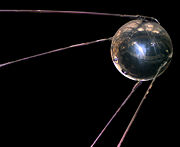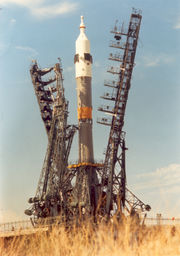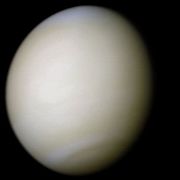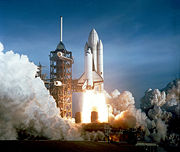Space Race
2008/9 Schools Wikipedia Selection. Related subjects: General history
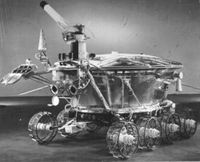
The 'Space Race' was a competition of space exploration between the Soviet Union and the United States, which lasted roughly from 1957 to 1975. It involved the efforts to explore outer space with artificial satellites, to send humans into space, and to land people on the Moon.
Space Race effectively began after the Soviet launch of Sputnik 1 on 4 October 1957. The term originated as an analogy to the arms race. The Space Race became an important part of the cultural, technological, and ideological rivalry between the United States and the Soviet Union during the Cold War. Space technology became a particularly important arena in this conflict, because of both its potential military applications and the morale-boosting social benefits.
Artificial satellites
Sputnik
On 4 October 1957, the Soviet Union successfully launched Sputnik 1, the first artificial satellite to orbit the Earth, thus beginning the Space Race. Because of its military and economic implications, Sputnik caused fear and stirred political debate in the United States, spurring the Eisenhower administration to enact several initiatives, including the formation of NASA. At the same time, the Sputnik launch was seen in the Soviet Union as an important sign of scientific and engineering capabilities of the nation.
In the Soviet Union, a country recovering from a devastating war, the launch of Sputnik and the following program of space exploration were met with great interest from the public.It was also important and encouraging for Soviet citizens to see the proof of technical prowess in the new era.
Before Sputnik, the average American assumed that the United States had superiority in all fields of technology. In response to Sputnik, the United States launched a huge effort to regain technological supremacy, including revamping the school curriculum. Within less than a year, the United States Congress passed the National Defense Education Act, the most far-reaching federally-sponsored education initiative in the nation's history. The bill authorized expenditures of more than $1 billion for a wide range of reforms including new school construction, fellowships and loans to encourage promising students to seek higher education, new efforts in vocational education to meet critical manpower shortages in the defense industry, and a host of other programs. This reaction is now known as the Sputnik crisis.
As with the Soviet public, the American public followed the succession of launches, and building replicas of rockets became a popular hobby.
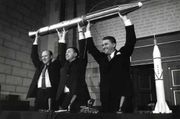
Nearly four months after the launch of Sputnik 1, the United States launched its first satellite, Explorer 1. In the meantime, several embarrassing launch failures had occurred at Cape Canaveral.
The first satellites were already used for scientific purposes. Sputnik helped to determine the density of the upper atmosphere, and Explorer 1 flight data led to the discovery of the Van Allen radiation belt by James Van Allen.
Satellite communications
The first American communications satellite, Project SCORE, launched on 18 December 1958, relayed a Christmas message from President Dwight D. Eisenhower to the world. Other notable examples of satellite communication during (or spawned by) the Space Race include:
- 1962: Telstar: the first "active" communications satellite (experimental transoceanic)
- 1972: Anik 1: first domestic communications satellite (Canada)
- 1974: Westar: first U.S. domestic communications satellite
- 1976: Marisat: first mobile communications satellite
- 1972: Anik 1: first domestic communications satellite (Canada)
The United States launched the first geosynchronous satellite, Syncom-2, on 26 July 1963. The success of this class of satellite meant that a simple satellite dish no longer needed to track the orbit of the satellite because that orbit remained geostationary. Henceforth ordinary citizens could use satellite-mediated communications transmissions for television broadcasts, after a one-time setup.
Living creatures in space
Animals in space
Fruit flies launched by the United States on captured German V-2 rockets in 1946 became the first reported animals sent into space for scientific study.
The first animal sent into orbit, the dog Laika (in English, "Barker"), traveled in the Soviet Union's Sputnik 2 in 1957. The dog was never meant to be returned back to Earth, and died of stress, overheating and dehydration several days after reaching space. In 1960 Soviet space dogs Belka and Strelka orbited the earth and successfully returned. (Russian)
The American space program imported chimpanzees from Africa and sent at least two into space before launching their first human orbiter. The Soviet Union launched turtles in 1968 on Zond 5, which became the first animals to fly around the Moon.
Humans in space
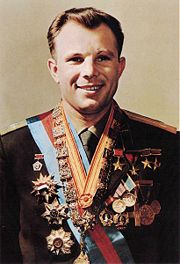
The Soviet cosmonaut Yuri Gagarin became the first human in space when he entered orbit in the Soviet Union's Vostok 1 on 12 April 1961, a day now celebrated as a holiday in Russia and in many other countries. He orbited the Earth for 108 minutes.
Twenty-three days later, on sub-orbital mission Freedom 7, Alan Shepard entered space for the United States, and John Glenn, in Friendship 7, became the first American to successfully orbit Earth, completing three orbits on 20 February 1962.
The first dual-manned flights also originated in the Soviet Union, on 11 August - 15 August 1962. Soviet Valentina Tereshkova became the first woman in space on 16 June 1963 in Vostok 6. Sergei Korolev, the Soviet Space Agency's chief designer, had initially scheduled further Vostok missions of longer duration, but following the announcement of the Apollo program, Premier Khrushchev demanded more firsts. The first flight with more than two crew members was the Soviet Union's Voskhod 1, a modified version of the Vostok craft, took off on 12 October 1964 carrying Komarov, Feoktistov, and Yegorov. This flight also marked the first occasion on which a crew did not wear spacesuits.
Alexey Leonov, from Voskhod 2, launched by the Soviet Union on 18 March 1965, carried out the first spacewalk. This mission nearly ended in disaster; Leonov almost failed to return to the capsule and, because of a poor retrorocket fire, the ship landed 1,600 kilometers (1,000 mi) off target. By this time Khrushchev had left office, and the new Soviet leadership would not commit to an all-out lunar landing effort.
Lunar missions
Though the achievements made by the United States and the Soviet Union brought great pride to their respective nations, the ideological climate ensured that the Space Race would continue at least until the first human walked on the Moon. Before this achievement, unmanned spacecraft had to first explore the Moon by photography and demonstrate their ability to land safely on it.
Unmanned probes
Following the Soviet success in placing the first satellite into orbit, the Americans focused their efforts on sending a probe to the Moon. They called this first attempt the Pioneer program. The Soviet Lunar program became operational with the launch of Luna 1 on 4 January 1959, and Luna 1 became the first probe to reach the vicinity of the Moon. The first craft to reach the surface of the Moon was Luna 2, launched on 12 September 1959. In addition to the Pioneer program, there were three specific American programs: the Ranger program, the Lunar Orbiter program, and the robotic Surveyor program, with the goal of locating potential Apollo landing sites on the Moon.
Lunar landing
After the Soviet successes, especially Gagarin's flight, United States President John F. Kennedy and Vice President Lyndon B. Johnson looked for an American project that would capture the public’s imagination. The Apollo Program met many of their objectives and promised to defeat arguments from politicians both on the left (who favored social programs) and the right (who favored a more military project).
Apollo’s advantages included:
- economic benefits to several key states in the next election;
- closing the " missile gap" claimed by Kennedy during the 1960 election through dual-use technology;
- technical and scientific spin-off benefits
In conversation with NASA’s director James E. Webb, Kennedy said:
Everything we do ought to really be tied in to getting on to the Moon ahead of the Russians... otherwise we shouldn't be spending that kind of money, because I'm not interested in space... The only justification (for the cost) is because we hope to beat the Soviet Union to demonstrate that instead of being behind by a couple of years, by God, we passed them.
Kennedy and Johnson managed to swing public opinion: by 1965, 58 percent of Americans favored Apollo, up from 33 percent in 1963. After Johnson became President in 1963, his continuing support allowed the program to succeed.
The Soviet Union showed a greater ambivalence about human visits to the Moon. Khrushchev wanted neither "defeat" by another power, nor the expense of such a project. In October 1963 he characterized the Soviet Union as "not at present planning flight by cosmonauts to the Moon", while adding that they had not dropped out of the race. A year passed before the Soviet Union committed itself to a Moon-landing attempt.
In December 1968, the United States became the front runner in the Space Race when James Lovell, Frank Borman, and Bill Anders orbited the moon. In doing so, they also became the first humans to celebrate Christmas in space and a few days later they safely splashed down.
Kennedy proposed joint programs, such as a Moon landing by American and Soviet astronauts and improved weather-monitoring satellites. Khrushchev, sensing an attempt to steal superior Russian space technology, rejected these ideas. Sergei Korolev, the Soviet Space Agency's chief designer who designed the R-7 rocket which sent Sputnik into orbit, had started promoting his Soyuz craft and the N1 launcher rocket that had the capacity for a manned Moon landing. Khrushchev directed Korolev's design bureau to arrange further space firsts by modifying the existing Vostok technology, while a second team started building a completely new launcher and craft, the Proton booster and the Zond, for a manned cislunar flight in 1966. In 1964 the new Soviet leadership gave Korolev the backing for a Moon landing effort and brought all manned projects under his direction. With Korolev's death and the failure of the first Soyuz flight in 1967, the coordination of the Soviet Moon landing program quickly unraveled. Korolev's first choice for a lunar landing was Vladimir Komarov, but with Komarov's death on the Soyuz 1 in 1967, Yuri Gagarin and Aleksei Leonov became the most likely candidates. However, with Gagarin's death and the successive launch failures of the N1 booster in 1969, plans for a manned landing suffered first delay and then cancellation.
While unmanned Soviet probes had reached the Moon before any U.S. craft, American Neil Armstrong became the first person to set foot on the lunar surface on 21 July 1969, after landing the previous day. Commander of the Apollo 11 mission, Armstrong received backup from command-module pilot Michael Collins and lunar-module pilot Buzz Aldrin in an event watched by over 500 million people around the world. Social commentators widely recognize the lunar landing as one of the defining moments of the 20th century, and Armstrong's words on his first touching the Moon's surface became similarly memorable:
Unlike other international rivalries, the Space Race was not motivated by the desire for territorial expansion. After its successful landings on the Moon, the United States explicitly disclaimed the right to ownership of any part of the Moon.
Other successes
Missions to other planets
The Soviet Union first sent planetary probes to both Venus and Mars in 1960. The first spacecraft to successfully fly by Venus, the United States' Mariner 2, did so on 14 December 1962. It sent back surprising data on the high surface temperature and air density of Venus. Since it carried no cameras, its findings did not capture public attention as did images from space probes, which far exceeded the capacity of astronomers' Earth-based telescopes.
The Soviet Union's Venera 7, launched in 1971, became the first craft to land on Venus. Venera 9 then transmitted the first pictures from the surface of another planet. These represent only two in the long Venera series; several other previous Venera spacecraft performed flyby operations and attempted landing missions. Seven other Venera landers followed.
The United States launched Mariner 10, which flew by Venus on its way to Mercury, in 1974. It became the first and only spacecraft to fly by Mercury for the next 34 years.
Mariner 4, launched in 1965 by the United States, became the first probe to fly by Mars; it transmitted completely unexpected images. The first spacecraft to land on Mars, Mars 3, launched in 1971 by the USSR, did not return pictures. The U.S. Viking landers of 1976 transmitted the first such pictures.
Launches and docking
The American Gemini 7 and Gemini 6 spaceflights completed the world's first space rendezvous mission between two manned spacecraft on 15 December 1965. The spacecrafts came within a meter and kept station with each other for several orbits.
The U.S. craft Gemini 8, performed the first orbital space docking on 16 March 1966. The first automatic space docking linked the Soviet Union's Cosmos-186 and Cosmos-188 (two unmanned Soyuz spacecraft) on 30 October 1967.
The first launch from the sea took place with the United States' Scout B, on 26 April 1967. The first space station, the Soviet Union's Salyut 1, commenced operations on 7 June 1971.
Military competition
Out of view, but no less real a competition, the drive to develop space for military uses paralleled scientific efforts. Well before the launch of Sputnik 1, both the United States and the Soviet Union started developing plans for reconnaissance satellites. The Soviet Zenit spacecraft, which by the dual-use designed in by Korolev eventually became Vostok, began as a photoimaging satellite. It competed with the United States Air Force's Discoverer series. Discoverer XIII provided the first payload recovered from space in August 1960—one day ahead of the first Soviet recovered payload.
Both the United States and the Soviet Union developed major military space programs, often following a pattern whereby the United States only completed a mockup before its program ended, while the Soviet Union built, or even orbited, theirs:
- Supersonic Intercontinental Cruise Missile: Navaho (test program stopped) vs. Buran cruise missile (plan)
- Small Winged Spacecraft: X-20 Dyna-Soar (mockup) vs. MiG-105 (flight-tested)
- Satellite Inspection Capsule: Blue Gemini (mockup) vs. Soyuz interceptor (plan)
- Military Space Station: MOL (plan) vs. Almaz (flown somewhat modified as Salyut 2, 3, and 5)
- Military Capsule with hatch in heat shield: Gemini B (tested crewless in space) vs. VA TKS, also known as Merkur space capsule (flown crewless as part of TKS)
- Ferry to Military Space Station: Gemini Ferry (plan) vs. TKS (flown crewless in space, and docked with a Salyut)
"End" of the Space Race
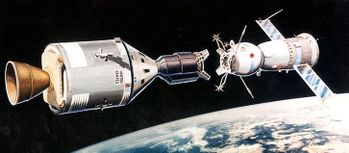
While the Sputnik 1 launch can clearly be called the start of the Space Race, its end is more debatable. Most hotly contested during the 1960s, the Space Race continued apace through the Apollo moon landing of 1969. Although they followed Apollo 11 with five more manned lunar landings, American space scientists turned to new arenas. Skylab was to gather data, and the Space Shuttle was intended to return spaceships intact from space journeys. Russians claimed that by first sending a man into space they had won this unofficial "race," however Americans claimed that by first landing a man on the moon they had won. In any event, as the Cold War subsided, and as other nations began to develop their own space programs, the notion of a continuing "race" between the two superpowers became less real.
Both nations had developed manned military space programs. The United States Air Force had proposed using its Titan missile to launch the Dyna-Soar hypersonic glider to use in intercepting enemy satellites. The plan for the Manned Orbiting Laboratory (using hardware based on the Gemini program to carry out surveillance missions) superseded Dyna-Soar, but this also suffered cancellation. The Soviet Union commissioned the Almaz program for a similar manned military space station, which merged with the Salyut program.
The Space Race slowed after the Apollo landing, which many observers describe as its apex or even as its end. Others, including space historian Carole Scott and Romanian Dr. Florin Pop's Cold War Project, feel its end came most clearly with the joint Apollo-Soyuz mission of 1975. The Soviet craft Soyuz 19 met and docked in space with America's Apollo, allowing astronauts from the "rival" nations to pass into each other's ships and participate in combined experimentation. Although each country's endeavors in space persisted, they went largely in different directions, and the notion of a continuing two-nation "race" became outdated after Apollo-Soyuz.
However, the Soviet leadership was alarmed at the prospect of U.S. Air Force involvement with the Space Shuttle program and began the competing Buran and Energia projects. In the early 1980s the commencement of the U.S. Strategic Defense Initiative further escalated competition that only resolved with the collapse of the Eastern Bloc in 1989.
Timeline (1957-1975)
| Date | Significance | Country | Mission Name |
|---|---|---|---|
| August 21, 1957 | First intercontinental ballistic missile (ICBM) | R-7 Semyorka/SS-6 Sapwood | |
| October 4, 1957 | First artificial satellite First signals from space |
Sputnik 1 | |
| November 3, 1957 | First animal in orbit, the dog Laika | Sputnik 2 | |
| January 31, 1958 | First detection of Van Allen belts | Explorer 1 | |
| March 17, 1958 | First solar powered satellite | Vanguard 1 | |
| December 18, 1958 | First communications satellite | Project SCORE | |
| January 2, 1959 | First firing of a rocket in Earth orbit First reaching Earth escape velocity First detection of solar wind |
Luna 1 | |
| January 4, 1959 | First man-made object in heliocentric orbit | Luna 1 | |
| February 17, 1959 | First weather satellite | Vanguard 2 | |
| February 28, 1959 | First satellite in a Polar orbit | Discoverer 1 | |
| August 7, 1959 | First photograph of Earth from orbit | Explorer 6 | |
| September 13, 1959 | First impact into another world (the Moon) | Luna 2 | |
| October 4, 1959 | First photos of far side of the Moon | Luna 3 | |
| April 1, 1960 | First Imaging weather satellite | TIROS-1 | |
| July 5, 1960 | First reconnaissance satellite | GRAB-1 | |
| August 11, 1960 | First satellite payload recovered intact from orbit | Discoverer 13 | |
| August 12, 1960 | First passive communications satellite | Echo 1A | |
| August 18, 1960 | First photo reconnaissance satellite | KH-1 9009 | |
| 1961 | First launch from orbit First mid-course corrections First spin-stabilisation |
Venera 1 | |
| April 12, 1961 | First manned spaceflight (Yuri Gagarin) First manned orbital flight |
Vostok 1 | |
| March 7, 1962 | First orbital solar observatory | OSO-1 | |
| December 14, 1962 | First planetary flyby (Venus closest approach 34,773 kilometers) | Mariner 2 | |
| June 16, 1963 | First woman in space ( Valentina Tereshkova) | Vostok 6 | |
| July 19, 1963 | First reusable manned spacecraft (suborbital) | X-15 Flight 90 | |
| July 26, 1963 | First geosynchronous satellite | Syncom 2 | |
| December 5, 1963 | First satellite navigation system | NAVSAT | |
| August 19, 1964 | First geostationary satellite | Syncom 3 | |
| October 12, 1964 | First multi-man crew (3 members) | Voskhod 1 | |
| March 18, 1965 | First extra-vehicular activity | Voskhod 2 | |
| July 14, 1965 | First Mars flyby (closest approach 9,846 kilometers) | Mariner 4 | |
| December 15, 1965 | First orbital rendezvous (parallel flight, no docking) | Gemini 6A/ Gemini 7 | |
| February 3, 1966 | First soft landing on another world (the Moon) First photos from another world |
Luna 9 | |
| March 1, 1966 | First impact into another planet (Venus) | Venera 3 | |
| March 16, 1966 | First orbital rendezvous (docking) | Gemini 8/ Agena target vehicle | |
| April 3, 1966 | First artificial satellite around another world (the Moon) | Luna 10 | |
| June 2, 1966 | soft landing on the Moon photos from the Moon |
Surveyor 1 | |
| April 23, 1967 | First spaceflight casualty | Soyuz 1 | |
| October 30, 1967 | First unmanned rendezvous with docking | Cosmos 186/ Cosmos 188 | |
| December 21, 1968 | First human orbiting of another celestial body (Moon) | Apollo 8 | |
| January 16, 1969 | First manned docking and exchange of crew | Soyuz 4/ Soyuz 5 | |
| July 21, 1969 | First human on the Moon and first space launch from a celestial body | Apollo 11 | |
| November 19, 1969 | First rendezvous on the surface of a celestial body | Apollo 12/ Surveyor 3 | |
| September 24, 1970 | First automatic sample return from the Moon | Luna 16 | |
| November 23, 1970 | First lunar rover | Lunokhod 1 | |
| December 12, 1970 | First X-ray orbital observatory | Uhuru (satellite) | |
| December 15, 1970 | First soft landing on another planet (Venus) First signals from another planet |
Venera 7 | |
| April 23, 1971 | First space station | Salyut 1 | |
| June, 1971 | First Manned orbital observatory | Orion 1 | |
| November 14, 1971 | First orbit around another planet (Mars) | Mariner 9 | |
| November 27, 1971 | First impact into Mars | Mars 2 | |
| December 2, 1971 | First soft Mars landing First signals from Mars surface |
Mars 3 | |
| March 3, 1972 | First human made object sent on escape trajectory away from the Sun | Pioneer 10 | |
| July 15, 1972 | First mission to enter the asteroid belt and leave inner solar system | Pioneer 10 | |
| December 3, 1973 | First Jupiter flyby (at 130,000 km) | Pioneer 10 | |
| February 5, 1974 | Venus flyby at 5768 kilometers, first gravitational assist manoeuvre | Mariner 10 | |
| March 29, 1974 | First Mercury flyby at 703 kilometers | Mariner 10 | |
| July 15, 1975 | First multinational manned mission | Apollo-Soyuz Test Project |
Organization, funding, and economic impact
The huge expenditures and bureaucracy needed to organize successful space exploration led to the creation of national space agencies. The United States and the Soviet Union developed programs focused solely on the scientific and industrial requirements for these efforts.
On 29 July 1958, President Eisenhower signed the National Aeronautics and Space Act, establishing the National Aeronautics and Space Administration ( NASA). When it began operations on 1 October 1958, NASA consisted mainly of the four laboratories and some 8,000 employees of the government's 46-year-old research agency for aeronautics, the National Advisory Committee for Aeronautics (NACA). While its predecessor, NACA, operated on a US$5 million budget, the NASA budget rapidly accelerated to US$5 billion per year, including huge sums for subcontractors from the private sector. The Apollo 11 Moon landing, the high point of NASA's success, cost an estimated 20 to 25 billion dollars.
The amount spent by USA on the space race from 1957 - 1975 is estimated to be about $100 billion in 2004 inflation adjusted dollars.
Lack of reliable statistics makes it difficult to compare U.S. and Soviet Union space spending, especially during the Khrushchev years. However in 1989, the Chief of Staff of the Soviet Armed Services, General M. Moiseyev, reported that the Soviet Union had allocated 6.9 billion rubles (about US$4 billion) to its space program that year. Other Soviet officials estimated that their total manned space expenses totalled about that amount over the entire duration of the programs, with some lower unofficial estimates of about four and half billion rubles. In addition to ambiguity of the figures, such comparisons must also take into account the likely effect of Soviet propaganda, which pursued the goal of making the Soviet Union look strong and of confusing the Western analysis.
Organizational issues, particularly internal rivalries, also plagued the Soviet effort. The Soviet Union had nothing like NASA (the Russian Aviation and Space Agency originated only in the 1990s). Too many political issues in science and too many personal views handicapped Soviet progress. Every Soviet chief designer had to stand for his own ideas, looking for the patronage of a communist official. In 1964, between the various chief designers, the Soviet Union was developing 30 different programs of launcher and spacecraft design. Following the death of Korolev, the Soviet space program became reactive, attempting to maintain parity with the United States. In 1974 the Soviet Union reorganized its space program, creating the Energia project to duplicate the U.S. Space Shuttle with Shuttle Buran.
The Soviets also operated in the face of an economic disadvantage. Although the Soviet economy was the second largest in the world; the U.S. economy was the largest. Some observers have argued that the high economic cost of the space race, along with the extremely expensive arms race, eventually deepened the economic crisis of the Soviet system during the late 1970s and 1980s and was one of the factors that led to the collapse of the Soviet Union.
Legacy
Deaths
When the United States' Apollo 15 left the moon, the astronauts left behind a memorial to astronauts from both nations who had perished during the efforts to reach the Moon. In the United States, the first astronauts to die during direct participation in space travel or preparation served in Apollo 1: Command Pilot "Gus" Grissom, Senior Pilot Ed White, and Pilot Roger Chaffee. These three died in a fire during a ground test on 27 January 1967.
Flights of the Soviet Union's Soyuz 1 and Soyuz 11 resulted in cosmonaut deaths. Soyuz 1, launched into orbit on 23 April 1967, carried a single cosmonaut, Colonel Vladimir Komarov, who died when the spacecraft crashed after return to Earth because of parachute failure. In 1971, Soyuz 11 cosmonauts Georgi Dobrovolski, Viktor Patsayev, and Vladislav Volkov asphyxiated during reentry. Since 1971, the Soviet/Russian space program has suffered no further losses.
Other astronauts died in related missions, including four Americans (Ted Freeman, Elliot See, Charlie Bassett, C.C.Williams) who died in crashes of T-38 aircraft. Soviet Yuri Gagarin, the first man in space, met a similar death when he crashed in a MiG-15 'Fagot' fighter in 1968.
Many believe that the worst disaster in rocketry was the R-16 failure in 1960, when improper shutdown and control procedures during hasty on-pad repairs caused the missile's second stage to fire straight onto the full propellant tanks in the still-attached first stage. The toxic fuel and fire killed around 100 top Soviet military and technical personnel.
Another candidate for the title of worst rocketry disaster was the N-1 explosion on June 3 1969. A loose bolt was sucked up a fuel pump, and after an engine shutdown the rocket hit the launchpad, thus destroying itself and the launch facility. In the disaster, many people at or near the site were killed.
Advances in technology and education
Technology, especially in aerospace engineering and electronic communication, advanced greatly during this period. The effects of the Space Race however went far beyond rocketry, physics, and astronomy. "Space age technology" extended to fields as diverse as home economics and forest defoliation studies, and the push to win the race changed the very ways in which students learned science.
American concerns that they had fallen so quickly behind the Soviets in the race to space led quickly to a push by legislators and educators for greater emphasis on mathematics and on the physical sciences in American schools. The United States' National Defense Education Act of 1958 increased funding for these goals from childhood education through the post-graduate level. To this day over 1,200 American high schools retain their own planetarium installations, a situation unparalleled in any other country worldwide and a direct consequence of the Space Race.
The scientists fostered by these efforts helped develop for space exploration technologies which have seen adapted uses ranging from the kitchen to athletic fields. Dried watermelon and ready-to-eat foods, in particular food sterilisation and package sealing techniques, stay-dry clothing, and even no-fog ski goggles have their roots in space science.
Today over a thousand artificial satellites orbit earth, relaying communications data around the planet and facilitating remote sensing of data on weather, vegetation, and human movements to nations who employ them. In addition, much of the micro-technology which fuels everyday activities from time-keeping to enjoying music derives from research initially driven by the Space Race.
And with all these advances since the first Sputnik was launched, the former Soviet Union's R-7 rocket, that marked the beginning the space race, is still in use today, notably servicing the ISS.
Recent events
Although its pace has slowed, space exploration continues to advance long after the demise of the Space Race. The United States launched the first reusable spacecraft (space shuttle) on the 20th anniversary of Gagarin's flight, 12 April 1981. On 15 November 1988, the Soviet Union launched Buran, their first and only reusable spacecraft. These and other nations continue to launch probes, satellites of many types, and huge space telescopes.
The possibility of a second international space race appeared at the end of the 20th century, with the European Space Agency taking the lead in commercial rocket launches with Ariane 4, and competing in unmanned space exploration with NASA. ESA's efforts have culminated into ambitious plans such as the Aurora Programme that intends to send a human mission to Mars no later than 2030 and has set various flagship missions to reach this goal. With U.S. President George W. Bush's similar announcement in 2004, outlining a timeframe for the construction and mission plan of the Crew Exploration Vehicle (a subsequent return to the Moon and later to Mars by 2030), the two major space agencies have similar plans. The ESA has teamed up with Russia. They are likely to co-fund and develop the Crew Exploration Vehicle counterpart, Kliper, which is scheduled to launch in 2011, years earlier than its American opponent, which is in an early draft status. As of 2006 the ESA has yet to fund a study of Kliper.
Other nations are also capable of increasing competition in space exploration, most notably Japan, China, and India. Although China's funding is not in the same league with ESA or NASA, the successful manned space flights of Shenzhou 5 and Shenzhou 6 and plans for a space station by the Chinese space program of the People's Republic of China have shown what the country can accomplish. The United States military is evidently keeping a close watch on China's space aspirations, with the Pentagon releasing a report in 2006 detailing concerns about China's growing space power.In early 2007 China launched a ballistic missile to destroy a satellite, frustrating international observers as this had violated a consensus not to attempt such maneuvers in space that have military undertones. This was some token that the space race had not really ever ended and actually had only expanded. In addition to China, India also has active space programs, with India's national space agency, ISRO, planning to launch an unmanned lunar mission, Chandrayaan-1, by early 2008. India also has plans for manned space flights and an unmanned mission to Mars in 2012. The Japanese Space Agency, JAXA, has launched a moon probe, SELENE in 2007. SELENE is touted as the most sophisticated lunar exploration mission in the post-Apollo Era.
Satellite launching order, by nation
Few countries have successfully launched a satellite independently. The countries which have accomplished this include (sequentially, as of February, 2007), former Soviet Union, U.S.A., France, Japan, China,U.K., India and Israel. Kazakhstan has rocket and satellite development technology and hosts the Baikonur Cosmodrome launch facility which is used by other countries particularly Russia. Brazil made three attempts at satellite launching in 97, 99, 03 years but none of these were successful.
| Rnk | Date | Nation | Satellite | Name | kg | Remarks |
|---|---|---|---|---|---|---|
| 1 | 1957 (10.4) | Soviet Union | Sputnik 1 | R-7 | 84 kg | |
| 2 | 1958 (1.31) | U.S.A. | Explorer 1 | Jupiter C | 13.7 kg | |
| 3 | 1965 (11.26) | France | Aesterix 1 | Deer man | ||
| 4 | 1970 (2.11) | Japan | おおすみ/ Osumi | L-4S 5 | 23.8 kg | |
| 5 | 1970 (4.24) | China | 東方紅 | 長征1型 | ||
| 6 | 1971 (10.28) | U.K. | Prospero | Black arrow | in Australia | |
| 7 | 1979 (12.24) | ESA | CAT | Alian 1type(L01) | ||
| 8 | 1980 (7.18) | India | Rohini1 | SLV | ||
| 9 | 1988 (9.19) | Israel | Ofeq 1 | Shabit | launching westward |
Number of satellites launched, by nation
By the end of 2006, the total number of satellites launched worldwide was 5,736. The CIS and the U.S. launched roughly 88% of these. Below is a list of the top ten satellite-launching nations as of December 2006. Joint possession is not included.
| Rnk | Nation | Number (2005) |
|---|---|---|
| 1 | CIS | 3228 (3212) |
| 2 | U.S.A. | 1815 (1781) |
| 3 | Japan | 119 (111) |
| 4 | China | 99 (92) |
| INTELSAT | 70 (69) | |
| ESRO/ESA | 64 (63) | |
| 5 | France | 54 (52)In addition, France and Germany hold two planes jointly |
| 6 | India | 38 |
| 7 | Germany | 38 (37)In addition, France and Germany hold two planes jointly |
| 8 | U.K. | 35 |
| 9 | Canada | 27 (26) |
| 10 | Italy | 20 (19) |
Commercial space race
Another kind of space race may differ in nature from the original Soviet-American competition, as it could occur between commercial space enterprises. Early efforts in what is commonly referred to as space tourism, to run the first commercial trips into orbit, culminated on April 28, 2001 when American Dennis Tito became the first fee-paying space tourist when he visited the International Space Station on board Russia's Soyuz TM-32. The Ansari X Prize, a competition for private suborbital spaceships, has also evoked the prospect of a new space race by private companies. In late 2004, British aviator-financier Richard Branson announced the launch of Virgin Galactic, a company which will use SpaceShipOne technology, with hopes of launching sub-orbital flights by 2008.
